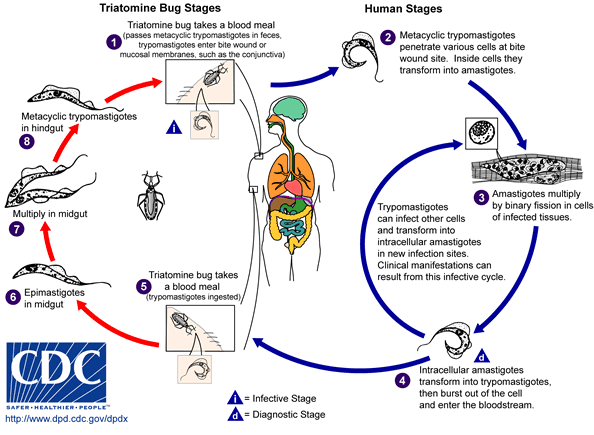Chagas Disease
Chagas disease, also known as American trypanosomiasis, is a tropical parasitic disease caused by Trypanosoma cruzi. It is primarily spread by insects of the subfamily Triatominae, commonly referred to as "kissing bugs".

Signs and Symptoms

Chagas disease has two distinct stages: acute and chronic. The acute stage develops one to two weeks after the insect bite, often presenting minor and non-specific symptoms such as fever, malaise, headache, and enlargement of the liver, spleen, and lymph nodes. A distinctive sign is the swollen nodule at the infection site, known as "Romaña's sign" when on the eyelid or "chagoma" on other skin areas. Severe acute disease is rare, affecting less than 1–5% of individuals, and can involve heart muscle inflammation, fluid around the heart, and brain inflammation.
The chronic stage, which can develop over decades, is often asymptomatic (indeterminate chronic Chagas disease). However, approximately 30–40% of people develop organ dysfunction (determinate chronic Chagas disease), primarily affecting the heart or digestive system. Heart disease, occurring in 14–45% of cases, can lead to heart palpitations, fainting, and heart failure. Digestive complications include enlarged oesophagus or colon, leading to symptoms like pain, swallowing difficulties, acid reflux, and constipation.
Cause and Transmission

Chagas disease is caused by the protozoan parasite T. cruzi, typically introduced into humans through the bite of triatomine bugs. The bugs defecate at the bite site, and motile T. cruzi forms called trypomastigotes enter the bloodstream. The disease can also spread through blood transfusion, organ transplantation, consumption of contaminated food or drink, and vertical transmission from mother to baby.
Diagnosis

Diagnosis in the acute phase involves detecting T. cruzi in the blood through microscopic examination or polymerase chain reaction (PCR). For chronic disease, serological tests detect antibodies against T. cruzi. Two positive serology results are required for confirmation. Rapid diagnostic tests are available for large-scale screening but require confirmation due to lower sensitivity.
Prevention

Prevention focuses on vector control by eliminating kissing bugs and avoiding their bites. This includes insecticide-spraying programmes, using bed nets, and housing improvements. Blood donations are screened for T. cruzi in many countries to prevent transfusion-related transmission. Treating infected mothers during pregnancy reduces congenital transmission risk.
Treatment

Antiparasitic drugs, mainly benznidazole and nifurtimox, are used to treat Chagas disease. Early treatment in the acute phase is highly effective, but efficacy decreases in chronic stages. Benznidazole is preferred due to milder side effects. Chronic disease management involves symptomatic treatment for heart and digestive complications. Heart disease management includes beta blockers, ACE inhibitors, anti-arrhythmic drugs, pacemakers, and potentially heart transplantation. Gastrointestinal issues may require laxatives, prokinetic drugs, or surgery in severe cases.
Epidemiology

Chagas disease is endemic in 21 countries in Latin America, with approximately 6.5 million people affected globally as of 2019. The disease is also present in non-endemic countries due to migration, with significant numbers in the United States and Europe. Efforts to control the disease include vector control programmes, blood screening, and public health campaigns.
Self-assessment MCQs (single best answer)
What is the primary cause of Chagas disease?
What stage of Chagas disease is characterised by minor, non-specific symptoms such as fever and malaise?
What is a distinctive sign of acute Chagas disease infection on the eyelid called?
Which organ is most commonly affected by chronic Chagas disease?
What is the vector responsible for transmitting Chagas disease?
Which diagnostic method is used to detect T. cruzi in the acute phase of Chagas disease?
What is the main approach to preventing Chagas disease?
Which drug is preferred for treating Chagas disease due to milder side effects?
In which region is Chagas disease endemic?
How is Chagas disease primarily diagnosed in the chronic phase?
Dentaljuce
Dentaljuce provides Enhanced Continuing Professional Development (CPD) with GDC-approved Certificates for dental professionals worldwide.
Founded in 2009 by the award-winning Masters team from the School of Dentistry at the University of Birmingham, Dentaljuce has established itself as the leading platform for online CPD.
With over 100 high-quality online courses available for a single annual membership fee, Dentaljuce offers comprehensive e-learning designed for busy dental professionals.
The courses cover a complete range of topics, from clinical skills to patient communication, and are suitable for dentists, nurses, hygienists, therapists, students, and practice managers.
Dentaljuce features Dr. Aiden, a dentally trained AI-powered personal tutor available 24/7 to assist with queries and provide guidance through complex topics, enhancing the learning experience.
Check out our range of courses, or sign up now!


